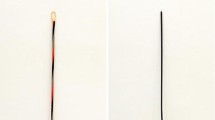Abstract
Background
The single-operator wire-guided cannulation technique in endoscopic retrograde cholangiopancreatography (ERCP) has been rarely reported.
Aims
This study was undertaken to determine the safety and efficiency of a single-operator wire-guided cannulation technique.
Methods
Four hundred sixty-five consecutive patients referred for ERCP were included in this prospective study and randomly divided into two groups. A new single-operator wire-guided cannulation technique was performed by the same experienced endoscopist, with experienced assistants (group A) and inexperienced ones (group B). The number of attempts at cannulation, cannulation time, success rate, and procedure-related complications were compared between the two groups.
Results
Successful cannulation was achieved in 460 out of the 465 patients (98.92 %). The incidences of post-ERCP pancreatitis, bleeding, infection, and perforation were 5.16, 0.64, 1.08, and 0 %, respectively. There were no severe complications or death. The cannulation time, number of attempts at cannulation and complications were not significantly different between the two groups (all P > 0.05).
Conclusions
The single-operator wire-guided cannulation technique was feasible, safe and efficient. It doesn’t require an experienced assistant and precise coordination between the assistant and endoscopist during cannulation.


Similar content being viewed by others
References
McCune WS, Shorb PE, Moscovitz H. Endoscopic cannulation of the ampulla of vater: a preliminary report. Ann Surg. 1968;167:752–756.
Adler DG, Baron TH, Davila RE, et al. ASGE guideline: the role of ERCP in diseases of the biliary tract and the pancreas. Gastrointest Endosc. 2005;62:1–8.
Jeurnink SM, Poley JW, Steyerberg EW, Kuipers EJ, Siersema PD. ERCP as an outpatient treatment: a review. Gastrointest Endosc. 2008;68:118–123. doi:10.1016/j.gie.2007.11.035.
Schwacha H, Allgaier HP, Deibert P, Olschewski M, Allgaier U, Blum HE. A sphincterotome-based technique for selective transpapillary common bile duct cannulation. Gastrointest Endosc. 2000;52:387–391. doi:10.1067/mge.2000.107909.
Cheon YK, Cho KB, Watkins JL, et al. Frequency and severity of post-ERCP pancreatitis correlated with extent of pancreatic ductal opacification. Gastrointest Endosc. 2007;65:385–393. doi:10.1016/j.gie.2006.10.021.
Lella F, Bagnolo F, Colombo E, Bonassi U. A simple way of avoiding post-ERCP pancreatitis. Gastrointest Endosc. 2004;59:830–834.
Karamanolis G, Katsikani A, Viazis N, et al. A prospective cross-over study using a sphincterotome and a guidewire to increase the success rate of common bile duct cannulation. World J Gastroenterol. 2005;11:1649–1652.
Artifon EL, Sakai P, Cunha JE, Halwan B, Ishioka S, Kumar A. Guidewire cannulation reduces risk of post-ERCP pancreatitis and facilitates bile duct cannulation. Am J Gastroenterol. 2007;102:2147–2153. doi:10.1111/j.1572-0241.2007.01378.x.
Katsinelos P, Paroutoglou G, Kountouras J, et al. A comparative study of standard ERCP catheter and hydrophilic guide wire in the selective cannulation of the common bile duct. Endoscopy. 2008;40:302–307. doi:10.1055/s-2007-995483.
Cennamo V, Fuccio L, Zagari RM, et al. Can a wire-guided cannulation technique increase bile duct cannulation rate and prevent post-ERCP pancreatitis? A meta-analysis of randomized controlled trials. Am J Gastroenterol. 2009;104:2343–2350. doi:10.1038/Ajg.2009.269.
Cheung J, Tsoi KK, Quan WL, Lau JYW, Sung JJY. Guidewire versus conventional contrast cannulation of the common bile duct for the prevention of post-ERCP pancreatitis: a systematic review and meta-analysis. Gastrointest Endosc. 2009;70:1211–1219. doi:10.1016/j.gie.2009.08.007.
Lee TH, Park DH, Park JY, et al. Can wire-guided cannulation prevent post-ERCP pancreatitis? A prospective randomized trial. Gastrointest Endosc. 2009;69:444–449. doi:10.1016/j.gie.2008.04.064.
Mazaki T, Masuda H, Takayama T. Prophylactic pancreatic stent placement and post-ERCP pancreatitis: a systematic review and meta-analysis. Endoscopy. 2010;42:842–853. doi:10.1055/s-0030-1255781.
Rabenstein T, Schneider HT, Nicklas M, et al. Impact of skill and experience of the endoscopist on the outcome of endoscopic sphincterotomy techniques. Gastrointest Endosc. 1999;50:628–636.
Robison LS, Varadarajulu S, Wilcox CM. Safety and success of precut biliary sphincterotomy: is it linked to experience or expertise? World J Gastroenterol. 2007;13:2183–2186.
Draganov PV, Kowalczyk L, Fazel A, Moezardalan K, Pan JJ, Forsmark CE. Prospective randomized blinded comparison of a short-wire endoscopic retrograde cholangiopancreatography system with traditional long-wire devices. Dig Dis Sci. 2010;55:510–515. doi:10.1007/s10620-009-1052-5.
Reddy SC, Draganov PV. ERCP wire systems: the long and the short of it. World J Gastroenterol. 2009;15:55–60.
Freeman ML, Nelson DB, Sherman S, et al. Complications of endoscopic biliary sphincterotomy. N Engl J Med. 1996;335:909–918.
Lopez A, Ferrer I, Villagrasa RA, et al. A new guidewire cannulation technique in ERCP: successful deep biliary access with triple-lumen sphincterotome and guidewire controlled by the endoscopist. Surg Endosc. 2011;25:1876–1882. doi:10.1007/s00464-010-1479-y.
Cotton PB, Lehman G, Vennes J, et al. Endoscopic sphincterotomy complications and their management: an attempt at consensus. Gastrointest Endosc. 1991;37:383–393.
Cotton PB, Garrow DA, Gallagher J, Romagnuolo J. Risk factors for complications after ERCP: a multivariate analysis of 11,497 procedures over 12 years. Gastrointest Endosc. 2009;70:80–88. doi:10.1016/j.gie.2008.10.039.
Andriulli A, Loperfido S, Napolitano G, et al. Incidence rates of post-ERCP complications: a systematic survey of prospective studies. Am J Gastroenterol. 2007;102:1781–1788. doi:10.1111/j.1572-0241.2007.01279.x.
Huibregtse K. Complications of endoscopic sphincterotomy and their prevention. N Engl J Med. 1996;335:961–963.
Joyce AM, Ahmad NA, Beilstein MC, et al. Multicenter comparative trial of the V-scope system for therapeutic ERCP. Endoscopy. 2006;38:713–716. doi:10.1055/s-2006-925446.
Conflict of interest
Drs. Qi-Yong Li, Lelin Pan, Qi Ling, Jian-Di He, Li-Xia Zhang, and Shu-Sen Zheng have no conflicts of interest or financial ties to disclose.
Author information
Authors and Affiliations
Corresponding author
Rights and permissions
About this article
Cite this article
Li, QY., Pan, L., Ling, Q. et al. Single-Operator Wire-Guided Cannulation Technique Enables Easier Cannulation of Endoscopic Retrograde Cholangiopancreatography. Dig Dis Sci 57, 3293–3298 (2012). https://doi.org/10.1007/s10620-012-2274-5
Received:
Accepted:
Published:
Issue Date:
DOI: https://doi.org/10.1007/s10620-012-2274-5




